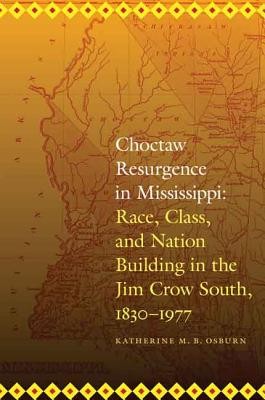
- We will send in 10–14 business days.
- Author: Katherine M B Osburn
- Publisher: University of Nebraska Press
- ISBN-10: 0803273878
- ISBN-13: 9780803273870
- Format: 15.1 x 23.2 x 2.1 cm, softcover
- Language: English
- SAVE -10% with code: EXTRA
Reviews
Description
When the Choctaws were removed from their Mississippi homeland to Indian Territory in 1830, several thousand remained behind, planning to take advantage of Article 14 in the removal treaty, which promised that any Choctaws who wished to remain in Mississippi could apply for allotments of land. When the remaining Choctaws applied for their allotments, however, the government reneged, and the Choctaws were left dispossessed and impoverished. Thus begins the history of the Mississippi Choctaws as a distinct people. Despite overwhelming poverty and significant racial prejudice in the rural South, the Mississippi Choctaws managed, over the course of a century and a half, to maintain their ethnic identity, persuade the Office of Indian Affairs to provide them with services and lands, create a functioning tribal government, and establish a prosperous and stable reservation economy. The Choctaws' struggle against segregation in the 1950s and 1960s is an overlooked story of the civil rights movement, and this study of white supremacist support for Choctaw tribalism considerably complicates our understanding of southern history. Choctaw Resurgence in Mississippi traces the Choctaw's remarkable tribal rebirth, attributing it to their sustained political and social activism. Katherine M. B. Osburn is an associate professor of history at Arizona State University. She is the author of Southern Ute Women: Autonomy and Assimilation on the Reservation, 1885-1934 (Nebraska, 2008).
EXTRA 10 % discount with code: EXTRA
The promotion ends in 9d.16:50:26
The discount code is valid when purchasing from 10 €. Discounts do not stack.
- Author: Katherine M B Osburn
- Publisher: University of Nebraska Press
- ISBN-10: 0803273878
- ISBN-13: 9780803273870
- Format: 15.1 x 23.2 x 2.1 cm, softcover
- Language: English English
When the Choctaws were removed from their Mississippi homeland to Indian Territory in 1830, several thousand remained behind, planning to take advantage of Article 14 in the removal treaty, which promised that any Choctaws who wished to remain in Mississippi could apply for allotments of land. When the remaining Choctaws applied for their allotments, however, the government reneged, and the Choctaws were left dispossessed and impoverished. Thus begins the history of the Mississippi Choctaws as a distinct people. Despite overwhelming poverty and significant racial prejudice in the rural South, the Mississippi Choctaws managed, over the course of a century and a half, to maintain their ethnic identity, persuade the Office of Indian Affairs to provide them with services and lands, create a functioning tribal government, and establish a prosperous and stable reservation economy. The Choctaws' struggle against segregation in the 1950s and 1960s is an overlooked story of the civil rights movement, and this study of white supremacist support for Choctaw tribalism considerably complicates our understanding of southern history. Choctaw Resurgence in Mississippi traces the Choctaw's remarkable tribal rebirth, attributing it to their sustained political and social activism. Katherine M. B. Osburn is an associate professor of history at Arizona State University. She is the author of Southern Ute Women: Autonomy and Assimilation on the Reservation, 1885-1934 (Nebraska, 2008).


Reviews